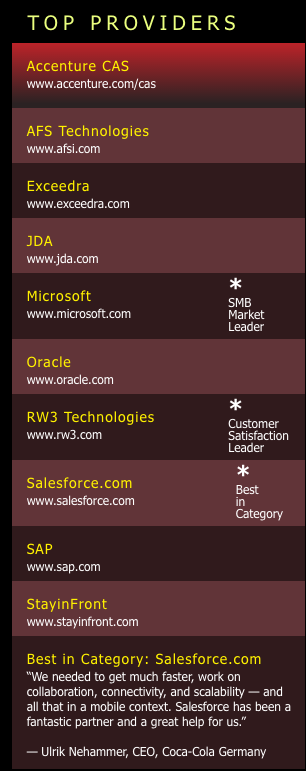2016 Readers' Choice Survey: Customer Relationship Management
Analyst: Trey Alexander, Principal, PwC Strategy&

Salesforce continues to be a strong player in the broader customer relationship management (CRM) market with particular relevance to consumer goods (CG) companies in the retail execution space where they have competed well against SAP and CAS. The solution was one of the first to develop a flexible, cloud-based platform, which positioned them well as companies began to seek cloud solutions. In addition, Salesforce easily supports multiple end-user platforms, while some of the other solutions are still playing catch-up in this area. Salesforce has not traditionally been a leader in the sales and trade-planning arena, but that could soon change as Accenture CAS has begun to develop a Salesforce version of its products. While the timing and precise capabilities remain unclear, our clients in the marketplace have been thinking about how this combination could or should impact their future roadmaps.
I’m not surprised to see Microsoft doing quite well in this year’s results, particularly in the SMB space. Office 365 provides a natural “jump-in point” for smaller companies wanting to move into the cloud — the applications are familiar and can now be deployed across all end-user platforms (PC’s, Mac’s, phones and tablets). Over the past year, I have seen several impressive demonstrations of the MS Dynamics CRM solution, which leverages Outlook for typical CRM functionalities such as contact and lead management. For companies that already leverage Outlook, expanding into CRM does not require learning an entirely new application. Reporting and analytics has also been enhanced with Power BI which makes integrating dashboards and visual reporting simpler.
In the trade promotion management (TPM) space, Accenture CAS and SAP continue to be the dominant players, particularly for large CG companies. In fact, these solutions tend to be the two finalists in most of our client’s selection efforts. The cost of these solutions has typically been prohibitive for smaller CG companies. However, both are extending their reach into smaller companies with their accelerator versions. These solutions focus on getting a basic version deployed quickly by leveraging pre-configured solutions for some of the more standard TPM capabilities, while still offering customization flexibility where necessary.
One area these solutions can and should continue to improve on is customer-planning capabilities. Most solutions force teams to build plans by entering detailed (often transaction-level) activities that then aggregate into a yearly plan. This can be overly time-consuming, particularly when a planner is simply trying to create a framework for delivering against his/her goals for the year. An ideal solution would allow a team to quickly build an initial top-down plan for the customer that is enhanced with execution details when they are known and agreed to with the retailer. Ultimately, spreadsheet planning will likely continue until this more robust type of capability is in place.
